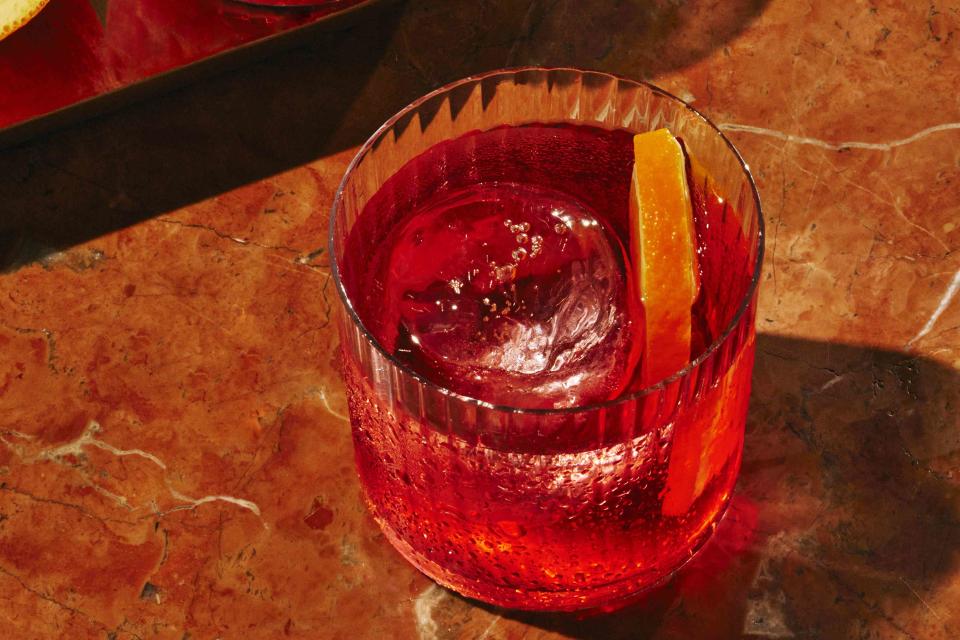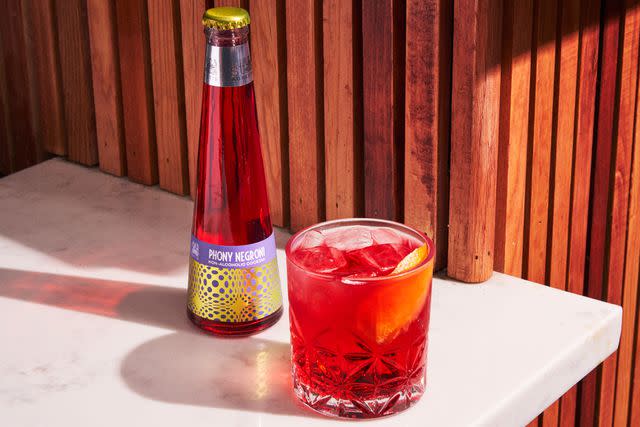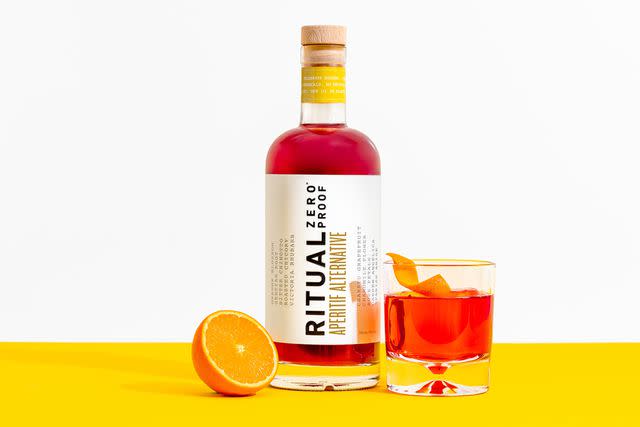How Did the Negroni Become the Most Popular Nonalcoholic Cocktail?
We've reached peak nonalcoholic Negroni — now what?

Martini & Rossi
Take a look at the menu at any bar or restaurant that has decided to invest in its nonalcoholic beverage program beyond offering Diet Coke or sparkling water, and you’ll likely notice a spritz or some sort of highball featured. Bonus points if there’s a zero-proof beer or wine listed, the latter of which is usually white or sparkling.
These drinks are based on beverages that are comparatively lower in alcohol to begin with, making them easier to translate into booze-free riffs. So how exactly did the Negroni, one of the most classically spirit-forward cocktails out there with a 1-1-1 ratio of gin, Campari, and sweet vermouth, become a mainstay of nonalcoholic drink lists?
The Phony Negroni effect
The popularization of the ready-to-drink (RTD) nonalcoholic Negroni came from Brooklyn-based St. Agrestis, a distillery known for reinvigorating the market for New York State-crafted contemporary amaro with the launch of their St. Agrestis Amaro in 2014. In 2018, a ready-to-drink alcoholic Negroni made with a base of Inferno, the distillery’s signature aperitif, hit shelves. Then, just one year later, the Phony Negroni — a zero-proof bottled Negroni that closely mimics the look and taste of the original — was born.
“Most nonalcoholic brands are utilizing flavor houses and co-packers, but since we have our own production space, we were able to have extremely high standards and be unwilling to bend on quality in a way that would have been next to impossible from afar,” says St. Agrestis co-founder Louis Catizone. “We always knew we needed to utilize the same 30 amazing botanicals that we had already been sourcing from five continents around the world, we just needed to learn how to extract them without alcohol. That process took nearly three years and quite a bit of discipline, but we're so proud of our proprietary process.”

Adam Friedlander / St. Agrestis
Today, the Phony Negroni is sold in over 2,000 restaurants and 1,000 retailers across all 50 U.S. states. In early 2022, St. Agrestis trademarked the term “phony negroni,” and subsequently launched trendy spin-offs like the Phony Mezcal Negroni and the Phony Espresso Negroni. For many restaurant and bar owners, carrying the bottles is an easy way to feed the growing demand for nonalcoholic offerings, and often more cost-effective than launching a dedicated nonalcoholic program from scratch.
But while many restaurants and bars serve St. Agrestis’ RTD by offering guests a chilled bottle or decanting it into a glass, a growing number are using it as a tried-and-true base for more creative riffs.
Death & Co’s flagship location recently offered The Moneyball, a smoky play on a Negroni with St. Agrestis’ Phony Negroni as its base, lapsang souchong tea, and nonalcoholic amaro. In Minneapolis, Laotian restaurant Khaluna ups the ante by serving a house brown butter-washed Phony Mezcal Negroni with smoked sage. Chacha Singsuwan, beverage director at Bangkok Supper Club in New York City, chooses to combine the Phony Negroni with longan juice, which her team makes in-house by boiling and soaking semi-dry longans (a tropical fruit often compared to lychee) so that their natural sweetness comes through into the cocktail.
“We had a tasting and I loved that St. Agestis distills the actual herbs and ingredients found in Negroni components like Campari, vermouth, and gin, versus simply extracting the alcohol,” says Singsuwan. “It's the perfect match for longan, which has a rich and bold flavor that adds depth while still allowing the bitterness to dominate.”
No alcohol, no limits
Despite its outsized exposure in the American market, St. Agrestis isn’t the only brand offering an RTD nonalcoholic Negroni.
There’s Lapo’s, a new can with cheeky branding inspired by Harry’s Bar in Florence, while plant-based mocktail company Little Saints offers a nonalcoholic Negroni Spritz. Drinkers can even opt for a functional twist on the classic from Highr, a brand that incorporates the amino acid L-theanine into its nonalcoholic Negroni Spritz in an effort to “reduce anxiety, improve mental sharpness, and lift mood.”
Other brands are positioning their nonalcoholic offerings as Negroni bait for bartenders who prefer to make their own cocktails. Markus Sakey, co-founder of Ritual Zero Proof, which launched its Aperitif Alternative last year, says his team had the classic Negroni in mind during the research and development phases for the product.

Ritual Zero Proof
“We specifically crafted the flavor profile to balance against gin, whether traditional or our nonalcoholic Gin Alternative,” he says. “We wanted a deep, herbaceous bitterness countered with a hint of sweetness, delicate warmth, a deeply satisfying smack in the tastebuds.”
Similarly, vermouth giant Martini & Rossi’s North American brand ambassador Fabio Raffaelli says that when rolling out the bright red nonalcoholic aperitif Vibrante last year, making sure the product could “seamlessly integrate” into a nonalcoholic Negroni was a top priority.
The right conditions for success
In many ways, we’re in the midst of a perfect storm for the nonalcoholic Negroni. According to Union, a point-of-sale operating system for hospitality businesses across the U.S., on-premise sales of the classic cocktail skyrocketed by 44% in many locations last summer. This surge goes hand-in-hand with Americans’ growing interest in aperitifs like Aperol, Lillet, Suze, and Campari, as well as an appreciation for strong, bitter flavors like those found in amaro, Cynar, and Genepy.
With 52% of Americans trying to drink less and 30% abstaining from alcohol altogether, flavor is more of a priority at the bar than ever before.
“The nonalcoholic version of a Negroni stands out among other nonalcoholic drinks in the accuracy of its mouthfeel and comparable taste to the original cocktail, largely due to [the availability] of some great products on the market,” says Davey Sarantos, bar lead at Majordomo in Los Angeles. “Nonalcoholic substitutions that carry the same viscosity and botanicals as vermouth and aperitivo bitters allow you to really replicate a nice sipping beverage with true complexity and weight on the palate.”
For more Food & Wine news, make sure to sign up for our newsletter!
Read the original article on Food & Wine.

